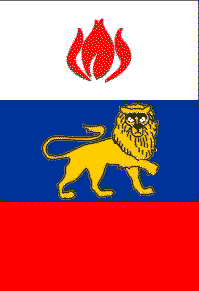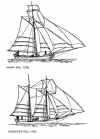
|
_____________
In this section of
____________
Go the section on _____________ Books: American Colonial and
Revolutionary War history or the people involved. We have suggestions
for you. _____________ Copyrighted.
© 2005
to Oct.2009, Leonard H. Bucklin.
-----
The
content of this site may not be reproduced except for brief excerpts for
reviews or scholarly references..
_____________
This is a history education and
research web site of the
|
Schooner. The word originated in Massachusetts, which started building
a new design of ship, larger than the sloop, but not a huge ship. The story
commonly told respecting the origin of the word as follows: When the first
schooner was being launched (at Gloucester, Mass., about 1713), a bystander
exclaimed "Oh, how she scoons!" The builder, Capt. Andrew Robinson,
replied, "A schooner let her be!" and the word at once came into use
as the name of the new type of vessel. A schooner is a small sea-going
fore-and-aft rigged vessel (versus squared rigged), originally with only two
masts, carrying one or more topsails. The rig characteristic of a schooner has
been defined as consisting essentially of two gaff sails, the after sail not
being smaller than the fore, and a head sail set on a bowsprit. This is a drawing of a typical one masted sloop and a typical two masted schooner. The brigantine would look something like a schooner, but be somewhat larger. Other than configuration of hull, a schooner and a brigantine had a sail difference. The brigantine had triangular main staysail while the schooner had a gaff foresail. See Howard I Chapelle, History of American Sailing Ships. pp. 11-13. (Bonanza Books, NY, 1995). Sloop. The general word "sloop" in the period 1700 to 1775, in the American colonies generally meant a single masted vessel of 25 to 70 tons burden. In general, it could be said that a sloop was the size of brigantine, but built on different lines, not as fast as a brigantine, but capable of holding more cargo. Because of the lines of construction (favoring capacity over speed), and the fact that it had one main mast only, it was called a sloop. The sloop was the most popular ship in the Eastern seaboard of America. However, great differences are found in how the word was used. The "sloop" Katy of Providence merchant John Brown was 110 feet long, clearly much larger than 70 tons burden usually associated with a large "sloop."
|


